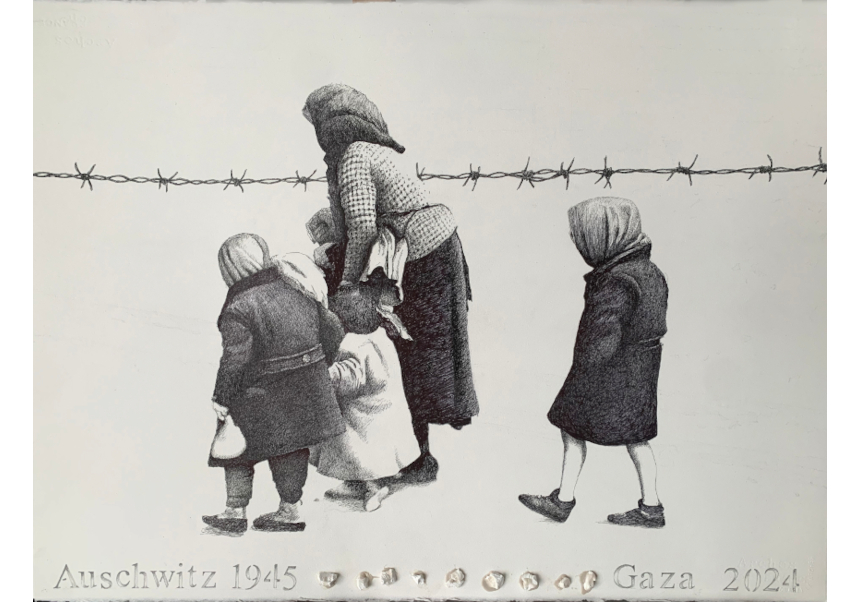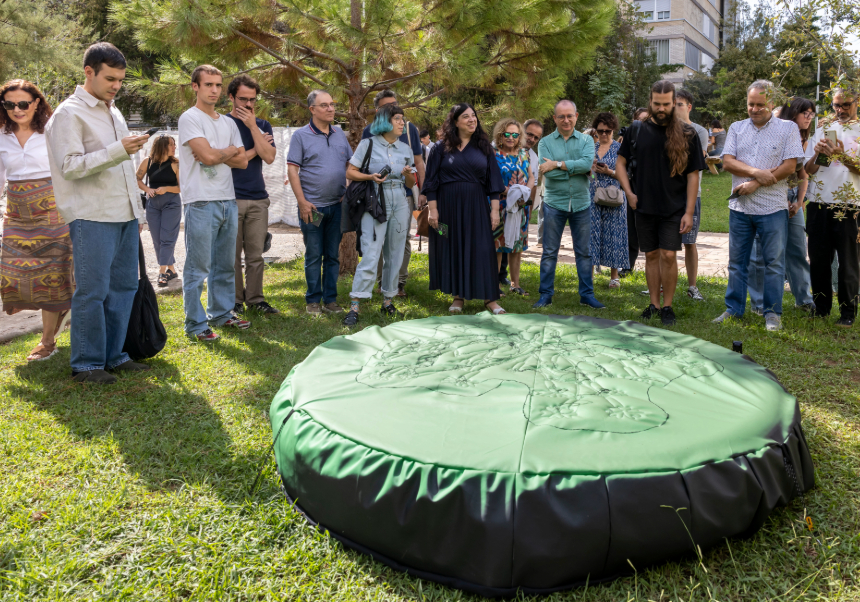Universitat de València opens an art exhibition by Artur Heras about memory with more than 200 pieces in La Nau
- University Culture Service
- November 11th, 2024

Universitat de València will open the “Halt! Thinking images” exhibition by Valencian artist Artur Heras (Xàtiva, 1945) on Tuesday 12 November at 10:00am in La Nau Cultural Centre. The exhibition was scheduled for 30 October but was postponed due to UV’s institutional mourning period for the DANA consequences. Attendants can visit this exhibition along with the rest of them in La Nau Cultural Centre until 12 November. Due to the situation and unlike the usual procedure, UV’s Office of the Vice-Principal for Culture and Society won’t hold an official inauguration nor a press conference. Even so, there will be two guided tours on 12 November at 11:00am and 19:30am with the artist and the curator.
“Halt! Thinking images” starts at the Senate and fills two rooms: The Academy and the General Study Hall. The exhibition presents more than 200 works combining painting, sketches, scultures, documentary information and audiovisuals. Most of them were created ex profeso for the exhibition, which holds an autobiographic air.
Heras is inspired by history, specifically by the nazi mass murders which most of his work is about. He welcomes the public to stop and see recent historical events, such as the far right wing evolution, civilan abuse, deportation of immigrants and Paletine bombardment. Hence the exhibition’s name Halt, which is German for Stop!.
Its name and illustration (an injured hand) make the public to say “Enough” of the terrible moments of the contemporary European history so that they won’t happen again.
Universitat de València Culture and Society Vice-Principal Ester Alba states “Artur Heras is one of the Valencian artists more upcoming in the century and this exhibition declares an undeniable commitment with progress and modern times” in agreement with curator Anacleto Ferrer, who describes Heras as “a painter of ideas” and a creator of “thinking images”, a term brought by philosopher Walter Benjamín: Denkbilder.
“Heras isn’t some cloud painter like Vladimir of Rilke, but a painter of ideas: his pieces do not only reflect on the reality they show or their artistic tradition, they also reflect on their own nature as images Heras isn’t aiming to cause understanding or agitation but to understand, communicate and appeal” explains curator and Universitat de València’s Philosophy Department’s Aesthetic and Art Theory chairman Anacleto Ferrer.
Heras goes deep into what came after the Auschwitz liberation apart from the nazi and francoism crimes: the emergence of ultranationalistic political parties and the far right wing.
Heras had an exhibition in La Nau 8 years ago and stated that he didn’t think of starting a collection about the Holocaust at first. The first sketch was a sky view of the Auschwitz camp, from the English air force in 1944. From that history dive, he thought about how was the world when he was born and explained it the only way he knows: drawing as if he was a botanist. The pieces in this exhibition started before the Covid-19 pandemic confinement. The isolation nurtured the insight needed in any creative work. Heras also explored his own biography: his uncles and aunts were on the exile lists of the Spanish Civil War of people that went on the Stanbrook, sailing from Alicante to Oran in 1939. He can see pictures of friends and relatives embedded in his work both current and that from his younger eras.
The exhibition tour takes off at the Senate with a 8 meter tall steel sculture with golden wings that represent the “Angel of History” of Walter Benjamin. The next stop is the Academy with “Wall of Words”, a room filled with pieces, reference items, sketches and elements of preparation and inspiration from the artist’s own studio along with voice records of victims, victimizers, witnesses, artists and intellectuals. There’s also a image frieze of convicts and responsibles sketched over police files from the concentration camps. They are close-up sketches in large format with charcoal and graphite pencil, reminiscing the work style of historical art academies. The room includes an immersive experience at its centre part to remind of Auschwitz: gravel and a large wagon image.
Heras highlights classic references in the General Study Hall. He pictures the martyrs of José de Ribera, large pieces remarkable for the attention to detail and present criticism. He also bring portraits of intellectuals that suffered the francoism: poets Federico García Lorca and Miguel Hernández, Principal Peset and diverse material: projections and around 50 pieces on this room.
The exhibition is organised by Universitat de València’s Office of the Vice-Principal for Culture and Society in collaboration with Valencian Provincial Council Democratic Memory and Xàtiva’s City Council. The exhibition will be open at Universitat de València until 12 January and will go to Xàtivas Museum of Fine Arts’ Espai Cultural Sant Domènec in Casa de l’Ensenyança starting 30 January 2025. The exhibition includes a detailed catalogue.
Artur Heras (Xàtiva, 1945) is a Spanish painter, sculptor and designer and e is one of the ost singular artists in the European art scene of the latest decades. His work is filled with social irony and criticism. One of its features is also the experimental use of the codes, wordplay and ironic sight of the art history. His 60s renovation along other celebrated artists liked to the “Reality chronicles” opened our eyes to a plural and heterodox reality, surpassing the challenges of the time for the creative work. Since then, he has walked numerous paths, leaving traces of his audacity and valor to explore the essence of communication and plastic expression. His excels in his direct yet refined style, spontaneous and blunt that comes from a meditated scene sense and concepts that take us to a mysterious and complex space of messages and discoveries.
More information:
Categories: Cultura , Exposicions , Centre Cultural La Nau
















